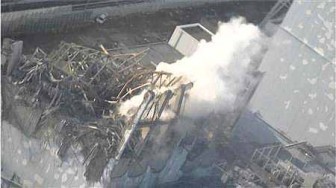TOKYO, (Reuters) – Japanese engineers raced to restore a power cable to a quake-ravaged nuclear power plant today in the hope of restarting pumps needed to pour cold water on overheating fuel rods and avert a catastrophic release of radiation.

Officials said they hoped to fix the cable to two reactors on Friday and to two others by Sunday, but said work would stop in the morning to allow helicopters and fire trucks to resume pouring water on the Fukushima Daiichi plant, about 240 km (150 miles) north of Tokyo.
“Preparatory work has so far not progressed as fast as we had hoped,” an official of plant operator Tokyo Electric Power Co (TEPCO) told a news briefing, adding that engineers had to be constantly checked for radiation levels.
Washington and other foreign capitals have expressed growing alarm about radiation leaking from the plant, severely damaged by a magnitude 9.0 earthquake and tsunami a week ago that triggered a series of destructive explosions and compromised the nuclear reactors and spent fuel storage tanks.
Worst case scenarios would involve millions of people in Japan threatened by exposure to radioactive material, but prevailing winds are likely to carry any contaminated smoke or steam away from the densely populated Tokyo area to dissipate over the Pacific ocean.
U.S. President Barack Obama said the crisis posed no risk to any U.S. territory. He nevertheless ordered a comprehensive review of domestic nuclear plants.
“We do not expect harmful levels of radiation to reach the United States, whether it’s the West Coast, Hawaii, Alaska, or U.S. territories in the Pacific,” Obama said. “That is the judgment of our Nuclear Regulatory Commission and many other experts.”
Yukiya Amano, head of the Vienna-based International Atomic Energy Agency (IAEA), was due back in his homeland later on Friday with an international team of experts after earlier complaining about a lack of information from Japan.
Graham Andrew, his senior aide, called the situation at the plant “reasonably stable “ but the government said white smoke or steam was still rising from three reactors and helicopters used to dump water on the plant had shown exposure to small amounts of radiation.
“The situation remains very serious, but there has been no significant worsening since yesterday,” Andrew said.
Even if TEPCO manages to connect the power, it is not clear the pumps will work as they may have been damaged in the earthquake or subsequent explosions.
U.S. officials took pains not to criticise Japan’s government, but Washington’s actions indicated a divide with its close ally about the perilousness of the world’s worst nuclear accident since the Chernobyl disaster in 1986.
COOLING POOL MAY
HAVE RUN DRY
The top U.S. nuclear regulator said the cooling pool for spent fuel rods at the complex’s reactor No.4 may have run dry and another was leaking.
Gregory Jaczko, head of the U.S. Nuclear Regulatory Commission, told a congressional hearing that radiation levels around the cooling pool were extremely high, posing deadly risks for workers still toiling in the wreckage of the power plant.
He said it could take weeks to successfully cool down the reactors.
Japan’s nuclear agency said it could not confirm if water was covering the fuel rods. The plant operator said it believed the reactor spent-fuel pool still had water as of Wednesday, and made clear its priority was the spent-fuel pool at the No.3 reactor.
Yesterday, military helicopters dumped about 30 tonnes of water, all aimed at this reactor. One emergency crew temporarily put off spraying the same reactor with a water cannon due to high radiation, broadcaster NHK said, but another crew later began hosing it.
Latest images from the plant showed severe damage, with two of the buildings a twisted mangle of steel and concrete.
DOLLAR GAINS AS FINANCIAL
LEADERS INTERVENE
The Group of Seven rich nations yesterday agreed to join in rare concerted intervention to restrain a run-away yen, hoping to calm global markets after a wild week of often panic selling.
The U.S. dollar immediately surged almost two yento 81.15 yen , leaving behind a record low of 76.25 hit on Thursday. Japan’s Nikkei share index climbed 2.5 percent, recouping some of the week’s stinging losses.
U.S. markets, which tanked on Wednesday on the back of the crisis, rebounded on Thursday but investors were not convinced the advance would last.
The government warned Tokyo’s 13 million residents to prepare for a possible large-scale blackout but later said there was no need for one. Still, many firms voluntarily reduced power, submerging parts of the usually neon-lit city in darkness. Yesterday, the U.S. embassy in Tokyo urged citizens living within 80 km (50 miles) of the Daiichi plant to evacuate or remain indoors “as a precaution”, while Britain’s foreign office urged citizens “to consider leaving the area”.




